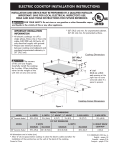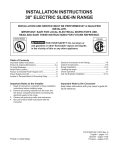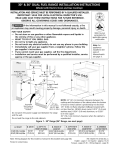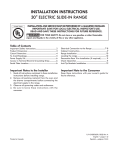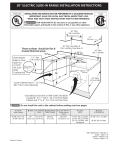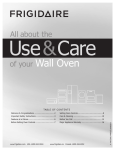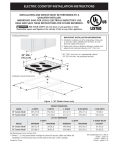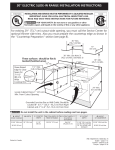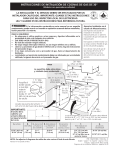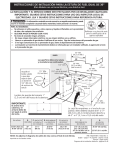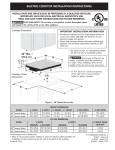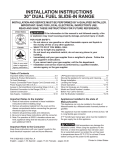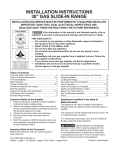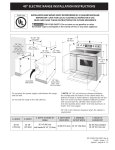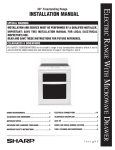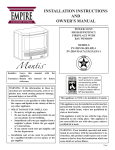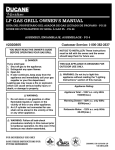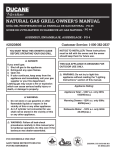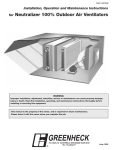Download Kenmore 4.2 cu. ft. Self-Clean Drop-In Electric Range - Black Installation Guide
Transcript
INSTALLATION INSTRUCTIONS 30" ELECTRIC DROP-IN RANGE INSTALLATION AND SERVICE MUST BE PERFORMED BY A QUALIFIED INSTALLER. IMPORTANT: SAVE FOR LOCAL ELECTRICAL INSPECTOR'S USE. READ AND SAVE THESE INSTRUCTIONS FOR FUTURE REFERENCE. United States FOR YOUR SAFETY: Do not store or use gasoline or other flammable vapors and liquids in the vicinity of this or any other appliance. Table of Contents Important Safety Instructions .........................................2 Cutout Dimensions .......................................................3-4 Electrical Requirements...................................................5 Electrical Connection .................................................. 5-6 Serial Plate Location .......................................................6 Range Installation ............................................................7 Anti-tip Bracket Installation........................................8-9 Check Operation ........................................................... 10 Model and Serial Number Location ........................... 10 Before you call for Service ........................................... 10 Important Notes to the Installer Important Note to the Consumer 1. Read all instructions contained in these installation instructions before installing range. 2. Remove all packing material from the oven and the drawer compartments before connecting the electrical supply to the range. 3. Observe all governing codes and ordinances. 4. Be sure to leave these instructions with the consumer. Printed in Canada Keep these instructions with your owner's guide for future reference. P/N 318201628 (1209) Rev. B English – pages 1-10 Español – páginas 11-20 30" ELECTRIC DROP-IN RANGE INSTALLATION INSTRUCTIONS IMPORTANT SAFETY INSTRUCTIONS This manual contains important safety symbols and instructions. Please pay attention to these symbols and follow all instructions given. This symbol will help alert you to situations that may cause serious bodily harm, death or property damage. This symbol will help alert you to situations that may cause bodily injury or property damage. • Be sure your range is installed and grounded reduce by installing a range hood that project properly by a qualified installer or ser vice horizontally a minimum of 5 inches beyond the technician. bottom of the cabinet. • This range must be electrically grounded in • Do not use the oven as a storage space. This accordance with local codes or, in their absence, creates a potentially hazardous situation. with the National Electrical Code ANSI/NFPA • Never use your range for warming or heating No. 70—latest edition. the room. Prolonged use of the range without • The installation of appliances designed for adequate ventilation can be dangerous. manufactured (mobile) home installation must • Do not store or use gasoline or other flammable conform with Manufactured Home Construction vapors and liquids near this or any other and Safety Standard, title 24CFR, part 3280 appliance. Explosions or fires could result. [Formerly the Federal Standard for Mobile Home • Reset all controls to the "off" position after using Construction and Safety, title 24, HUD (part a programmable timing operation. 280)] or when such standard is not applicable, FOR MODELS WITH SELF-CLEAN FEATURE: the Standard for Manufactured Home Installation • Remove broiler pan, food and other utensils before 1982 (Manufactured Home Sites, Communities self-cleaning the oven. Wipe up excess spillage. and Setups), ANSI Z225.1/NFPA 501A-latest Follow the pre cleaning instructions in the Use and edition, or with local codes. Care Guide. • Make sure the wall coverings around the range can withstand the heat generated by the range. Tip Over Hazard • Before installing the range in an area covered with • A child or adult can tip the linoleum or any other synthetic floor covering, range and be killed. make sure the floor covering can withstand heat • Verify the rear bracket is at least 90°F above room temperature without engaged with countertop or shrinking, warping or discoloring. Do not install the anti-tip device has been the range over carpeting unless you place an installed to the walls of the insulating pad or sheet of 1/4" thick plywood cabinet as per installation instructions. between the range and carpeting. • Ensure the anti-tip bracket is re-engaged with the countertop or to the cabinet side walls as Never leave children alone or per the installation instructions when the range unattended in the area where an appliance is in is moved. use. As children grow, teach them the proper, safe • Do not operate the range without the anti-tip use of all appliances. Never leave the oven door device in place and engaged. open when the range is unattended. • Failure to follow these instructions can result in death or serious burns to children and adults. Stepping, leaning or sitting on the door of this range can result in serious injuries and can also cause damage to the range. To check if the anti-tip bracket is installed properly, use both arms • Do not store items of interest to children in the and grasp the rear edge of range cabinets above the range. Children could be seriously back. Carefully attempt to tilt range burned climbing on the range to reach items. forward. When properly installed, • To eliminate the risk of burns or fire by reaching the range should not tilt forward. over heated surface units, cabinet storage space Refer to the anti-tip bracket installation instructions above the surface unit should be avoided. If supplied with your range for proper installation. cabinet storage is to be provided the risk can be 2 30" ELECTRIC DROP-IN RANGE INSTALLATION INSTRUCTIONS Cutout Dimensions 30" (76.2cm) 30" Min. (76.2 cm Min.) See Note 3 These surfaces should be flat & leveled (hatched area). 18" Min. 1/4” min. (45.7 cm Min.) 1/2” min. 1½" Max. (3.8 cm) Max. A Shave Raised Edge to Clear Space for a 31½" (81 cm) Wide Cooktop Rim. 31½" (81 cm) Exact C 1/2” min. App. 1-7/8" (4.8 cm) Locate Cabinet Doors 1" (2.5 cm) Min. from Cutout Opening 24" Min. (61 cm Min.) Grounded Junction Box in adjoining Cabinet Smoothtop Models . " Min 27½ Front Filler Support ANTI-TIP BRACKET AT REAR OF RANGE Front Cabinet Filler (If required) 48" (122 cm) Armored Cable NOTE: Two sets of holes are provided under antitip bracket. Bracket is attached in the upper hole position at the factory. Refer also to page 6, item 9 for additional details. A. Cutout Width (Countertop and cabinet) 30 ± 1/16" (76.2 ± 0.15 cm) 3 B. Cutout Depth C. Height of (According to front of Cutout cabinet) *see next page 21 3/4" (55.2 cm) min 29" (73.7 cm) 22 1/8" (56.2 cm) max 30" ELECTRIC DROP-IN RANGE INSTALLATION INSTRUCTIONS NOTES: 1. Do not pinch the power supply cord between the range and the wall. 2. Do not seal the range to the side cabinets. 3. 24" (61 cm) minimum clearance between the cooktop and the bottom of the cabinet when the bottom of wood or metal cabinet is protected by not less than 1/4" (0.64 cm) flame retardant millboard covered with not less than No. 28 MSG sheet metal, 0.015" (0.4 mm) stainless steel, 0.024" (0.6 mm) aluminum, or 0.020" (0.5 mm) copper. 30" (76.2 cm) minimum clearance when the cabinet is unprotected. 4. Allow at least 20" (50.1 cm) clearance for door Door open (see note 4) depth when it is open. IMPORTANT: Cabinet and countertop width should match the cutout width. 22 7/8"* (58.1 cm) min. 23 1/4"* (59.05 cm) max. A 1 1/8" (2.86 cm) FRONT OF CABINET A BRef. A. Cutout Width (Countertop and cabinet) 30 ± 1/16" (76.2 ± 0.15 cm) * For cutouts below 22 7/8", appliance will slightly show out of the cabinet. 4 B. Cutout Depth (According to front of cabinet) 21 3/4" (55.2 cm) min 22 1/8" (56.2 cm) max C. Height of Cutout 29" (73.7 cm) 30" ELECTRIC DROP-IN RANGE INSTALLATION INSTRUCTIONS 1 Electrical Requirements This appliance must be supplied with the proper voltage and frequency, and connected to an individual, properly grounded branch circuit, protected by a circuit breaker or fuse 40A or 50A. Electrical Shock Hazard • Electrical ground is required on this appliance. • Do not connect to the electrical supply until appliance is permanently grounded. • Disconnect power to the junction box before making the electrical connection. • This appliance must be connected to a grounded, metallic, permanent wiring system, or a grounding connector should be connected to the grounding terminal or wire lead on the appliance. • Do not use a gas supply line for grounding the appliance. Observe all governing codes and local ordinances 1. A 3-wire or 4-wire single phase 120/240 or 120/208 Volt, 60 Hz AC only electrical supply is required on a separate circuit fused on both sides of the line (red and black wires). A time-delay fuse or circuit breaker is recommended. DO NOT fuse neutral (white wire). NOTE: Wire sizes and connections must conform with the fuse size and rating of the appliance in accordance with the American National Electrical Code ANSI/NFPA No. 70-latest edition, or with Canadian CSA Standard C22.1, Canadian Electrical Code, Part 1, and local codes and ordinances. Failure to do any of the above could result in a fire, personal injury or electrical shock. In cold weather shipping and storage conditions, make sure that oven is in final location at least three (3) hours before switching on power. Switching on power while oven is still cold may damage the oven controls. An extension cord should not be used with this appliance. Such use may result in a fire, electrical shock, or other personal injury. If you need a longer power cord you can purchase a 10' (3 m) power cord kit #903056-9010 by calling the Service Center. 2 Electrical connection It is the responsibility and obligation of the consumer to contact a qualified installer to assure that the electrical installation is adequate and is in conformance with the National Electrical Code ANSI/NFPA No. 70latest edition, or with CSA Standard C22.1, Canadian Electrical Code, Part 1, and local codes and ordinances. 2. These appliances should be connected to the fused disconnect (or circuit breaker) box through flexible armored or nonmetallic sheathed cable. The flexible armored cable extending from the appliance should be connected directly to the junction box. The junction box should be located as shown in Figure 1 or Figure 2 and with as much slack as possible remaining in the cable between the box and the appliance, so it can be moved if servicing is ever necessary. 3. A suitable strain relief must be provided to attach the flexible armored cable to the junction box. Risk of electrical shock (Failure to heed this warning may result in electrocution or other serious injury.) This appliance is equipped with copper lead wire. If connection is made to aluminum house wiring, use only connectors that are approved for joining copper and aluminum wire in accordance with the National Electrical Code and local code and ordinances. When installing connectors having screws which bear directly on the steel and/or aluminum flexible conduit, do no tighten screws sufficiently to damage the flexible conduit. Do not over bend or excessively distort flexible conduit to avoid separation of convolutions en exposure of internal wires. DO NOT ground to a gas supply pipe. DO NOT connect to electrical power supply until appliance is permanently grounded. Connect the ground wire before turning on the power. 5 30" ELECTRIC DROP-IN RANGE INSTALLATION INSTRUCTIONS If oven is used in a new branch circuit installation (1996 NEC), mobile home, recreational vehicle, or where local codes DO NOT permit grounding through the neutral (white) wire, the appliance frame MUST NOT be connected to the neutral wire of the 4-wire electrical system. (see figure 2): 1. Disconnect the power supply. 2. Separate the green (or bare copper) and white appliance cable wires. 3. In the junction box: Connect appliance and power supply cable wires as shown in Figure 2. (If your appliance is equipped with a white neutral conductor.) This appliance is manufactured with a white neutral power supply and a frame connected copper wire. The frame is grounded by connection of grounding lead to neutral lead at the termination of the conduit, if used in USA, in a new branch circuit installation (1996 NEC), mobile home, recreational vehicles, where local code do not permit grounding trough the neutral (white) wire or in Canada, disconnect the white and green lead from each other and use ground lead to ground unit in accordance with local codes, connect neutral lead to branch circuit-neutral conductor in usual manner see Figure 4. If your appliance is to be connected to a 3 wire grounded junction box (US only), where local code permit connecting the appliance-grounding conductor to the neutral (white) see Figure 3. Cable from Power Supply Ground Wire Black Wires NOTE TO ELECTRICIAN: The armored cable leads supplied with the appliance are UL-recognized for connection to larger gauge household wiring. The insulation of the leads is rated at temperatures much higher than temperature rating of household wiring. The current carrying capacity of the conductor is governed by the temperature rating of the insulation around the wire, rather than the wire gauge alone. Ground Wire (Bare or Green Wire) Junction Box White Wire U.L.-Listed Conduit Connector (or CSA listed) Cable from appliance Figure 2 4-WIRE GROUNDED JUNCTION BOX Where local codes permit connecting the appliancegrounding conductor to the neutral (white) wire (US Only) (see figure 1): 1. Disconnect the power supply. 2. In the junction box: connect appliance and power supply cable wires as shown in Figure 1. Serial Plate Location You will find the model and serial number printed on the serial plate. The serial plate is located as shown. Remember to record the serial number for future reference. Cable from Power Supply Black Wires White Wire (Neutral) White Wire Red Wires Red Wires Junction Box White Wire (Neutral) Ground Wire (Bare or Green Wire) U.L.-Listed Conduit Connector (or CSA listed) Cable from appliance Figure 1 3-WIRE GROUNDED JUNCTION BOX 6 30" ELECTRIC DROP-IN RANGE INSTALLATION INSTRUCTIONS Important Note: Door removal is not a requirement for installation of the range, but is an added convenience. The appliance should be placed on a table or the front of the appliance should be raised to be able to fully open the door. Please refer to the Use and Care Guide for oven door removal instructions. 3 Range Installation The electrical power to the range must be shut off while line connections are being made. Failure to do so could result in serious injury or death. Countertop Preparation • The cooktop sides of the range fit over the cutout edge of your countertop. • If you have a square finish (flat) countertop, no countertop preparation is required. Cooktop sides lay directly on edge of countertop. • Formed front-edged countertops must have molded edge shaved flat 3/4" (1.9 cm) from each front corner of opening (Figure 3). • Tile countertops may need trim cut back 3/4"(1.9 cm) from each front corner and/or rounded edge flattened (Figure 3). • If the existing cutout width is greater than 30 1/16" (76.4 cm), reduce the ¾" (1.9 cm) dimension. 1. ¾” (1.9 cm) Min. Cutout Width 2. 3. 31½” (81 cm) 4. Formed or tile countertop trimmed ¾" (1.9 cm) back at front corners of countertop opening. ¾” (1.9 cm) Figure 3 5. This range is designed to hang from the countertop. It does not rest on the floor. 6. 7. Be sure the bottom of any wall cabinets are a minimum of 30" (76.2 cm) above the rangetop area. To eliminate the hazard or reaching over heated surface units, cabinet storage space located above the surface units should be avoided. If cabinet storage is to be provided, the hazard can be reduced by installing a range hood that projects horizontally a minimum of 5" (12.7 cm) beyond the bottom front edge of the cabinets. 8. 7 Install base cabinets 30" (76.2cm) apart, and be sure they are plumb and level before attaching to countertop. Cut countertop exactly as shown in Figure 1. Shave raised edge level to clear 31 1/2" (81cm) wide rim on rolled edge styled countertops. Install the wiring junction box in an adjoining cabinet or under the floor (range has 48"/122cm of conduit). Cut 1-1/4" (3.2cm) hole to bring conduit to the junction box. To provide an optimum installation, the top surface of the countertop must be level and flat (lie on the same plane) around the 3 sides that are adjacent to range cooktop. Proper adjustments to make the top flat should be made or gaps between the countertop may occur. To reduce the risk of damaging your appliance, do not handle or manipulate it by the ceramic glass. Manipulate with care. Move range in front of cabinet opening. Push the electric conduit through the hole and attach it to the junction box. Leave enough slack in the conduit to allow the range to be pulled forward several inches for service if necessary. Oven door is heavy. It is advisable to remove door and eliminate its weight as range is lifted into position. See oven door removal instructions in the Use and Care Guide. NEVER lift the appliance by the control panel doing so may damage the control panel. Lift the range into position on the countertop and make sure the appliance is centered in the cutout opening to be sure that the flanges of the upper side panel are sitting on the countertop to avoid glass breakage. 30" ELECTRIC DROP-IN RANGE INSTALLATION INSTRUCTIONS 4 Anti-tip Bracket installation A. Preferred Anti-tip installation (All models) 1. The range is equipped with an anti-tip bracket attached to the back of the range with two screws. If countertop thickness is greater than 1/2" (1.3cm), relocate anti-tip bracket to the lower position 1/4" (6.4 mm) below (see figure 4). 2. Anti-slide brackets Installation (Figure 5): A.Place the range so that it is about 6" out of the cabinet. B. Insert from below the shoulder screws in the bottom bracket (one on each side) C. Slide the range into its final position. D. Position the "L" bracket against the side of the cabinet so that it is retained by the shoulder screws, hold bracket and mark the holes on the inside of the cabinet. Drill pilot holes into cabinet where you just marked (Caution should be taken to avoid drilling through the opposite side of the cabinet). Attach the "L" bracket to the cabinet with the screws provided (don't forget to insert the shoulder screw into the bracket). Figure 5 E. Repeat steps D on the other side. 3. Install the decorative lower trim under the door using the screws provided with the range. B. Alternate Anti tip installation (All models) 1. The range is equipped with two anti-tip "L" brackets located on each side of the range with two screws (see figure 6). ANTI-TIP BRACKET AT REAR OF RANGE ANTI-TIP "L" BRACKET ON EACH SIDE OF RANGE Figure 4 Figure 6 8 30" ELECTRIC DROP-IN RANGE INSTALLATION INSTRUCTIONS 2. Anti-Tip cabinet "L" brackets Installation: A.Install the anti-tip cabinet "L" brackets as shown on Figure 7, one on each side. B. Slide the range into its final position. (The anti-tip L brackets attached to the range should be located under the anti-tip cabinet L brackets when the range is at its final position.) 3. Install the decorative lower trim under the door using the screws provided with the range. C. Alternate Anti tip installation (Model with liftup cooktop only) 1. Anti-tip/anti-slide screws installation: A. Slide the range to its final position. B. Lift the cooktop and secure range burner box to cabinet with screws supplied to prevent range from tipping (Figure 8). 2. Install the decorative lower trim under the door using the screws provided with the range. Anti-Tip mounting screws 2 on each side Counter 6¼" CL 20" Anti-tip "L" bracket CL Figure 7 Figure 8 9 30" ELECTRIC DROP-IN RANGE INSTALLATION INSTRUCTIONS 5 Checking Operation Model and Serial Number Location Some models have manual controls. Refer to the Owner's Guide and check all controls for correct operation. The serial plate is located along the side of the oven door in the open position. When ordering parts for or making inquires about your oven, always be sure to include the model and serial numbers and a lot number or letter from the serial plate on your oven. Some models are equipped with an electronic oven control. Each of the functions has been factory checked before shipping. However, it is suggested that you verify the operation of the electronic oven controls once more. Refer to the Owner's Guide for operation. Follow the instructions for the Clock, Timer, Bake, Broil, Convection (some models) and Clean (some models) functions. Before You Call for Service Read the Avoid Service Checklist and operating instructions in your Owner's Guide. It may save you time and expense. The list includes common occurrences that are not the result of defective workmanship or materials in this appliance. Bake–After setting the oven to 350°F (177°C) for baking, the lower element in the oven should become red. Refer to the warranty in your Owner's Guide for our toll-free service number and address. Please call or write if you have inquiries about your product and/or need to order parts. Broil–When the oven is set to BROIL, the upper element in the oven should become red. Clean (some models)–When the oven is set for a self-cleaning cycle, the upper element should become red during the preheat portion of the cycle. After reaching the self-cleaning temperature, the lower element will become red. Convection (some models)–When the oven is set for convection baking or roasting, both elements cycle on and off alternately and the convection fan will turn. The convection fan will stop turning when the oven door is opened during convection baking or roasting. IMPORTANT NOTE: A fan inside the upper rear part above the oven (some models) provides additional cooling of the oven electrical and electronic components. The fan will continue to run after the oven has been operating at high temperatures. 10 INSTRUCCIONES DE INSTALACIÓN ESTUFA ELÉCTRICA EMPOTRABLE DE 30" LA INSTALACIÓN Y EL SERVICIO DEBEN SER EFECTUADOS POR UN INSTALADOR CALIFICADO. IMPORTANTE: GUARDE ESTAS INSTRUCCIONES PARA USO DEL INSPECTOR LOCAL DE ELECTRICIDAD. LEA Y GUARDE ESTAS INSTRUCCIONES PARA REFERENCIA FUTURA. Estados Unidos PARA SU SEGURIDAD: No almacene ni utilice gasolina u otros vapores y líquidos inflamables en la proximidad de este o de cualquier otro artefacto. Tabla de materias Importante instrucciones de seguridad ......................12 Gabinete dimensiones .............................................13-14 Requerimientos eléctricos ............................................. 15 Conexión eléctrica....................................................15-16 Ubicación de la placa de serie ...................................16 Conexión eléctrica a la cocina.............................. 21-22 Instalación de la estufa ................................................17 Instrucciones de instalación de la fijación anti-inclinación ...........................................18-19 Comprobación del funcionamiento ........................... 20 Ubicación del numero de modelo y de serie ........... 20 Antes de llamar al servicio ......................................... 20 Notas importantes para el instalador Nota importante para el consumidor 1. Lea todas las instrucciones antes de instalar la cocina. 2. Retire todo material de empaquetado del horno y de la gaveta de entibiado antes de conectar el suministro eléctrico a la cocina. 3. Observe todo código o reglamento. 4. Asegúrese de dejar estas instrucciones con el consumidor Impreso en Canada Mantenga estas instrucciones con el manual del usuario para futuras referencias. P/N 318201628 (1209) Rev. B English – pages 1-10 Español – páginas 11-20 INSTRUCCIONES DE INSTALACIÓN PARA LA ESTUFA ELÉCTRICA EMPOTRABLE DE 30" IMPORTANTES INSTRUCCIONES DE SEGURIDAD Este manual contiene importantes mensajes de seguridad. Siempre lea y obedezca todo mensaje de seguridad. Indica una situación muy peligrosa, la cual de no ser evitada puede ocasionar graves heridas y hasta la muerte. ATENCION Indica una situación de peligro inminente, la cual de no ser evitada puede ocasionar heridas leves o daños al producto solamente. • Asegúrese que su cocina está instalada y conectada adecuadamente a tierra por un instalador calificado o un técnico de servicio. • Esta cocina debe ser conectada a tierra eléctricamente de acuerdo con los códigos locales, o de no existir, con la National Electrical Code ANSI/NFPA No.70- última edición. • La instalación de electrodomésticos destinados para casas (movibles) deben conformarse con la Manufactured Home Construction and Safety Standard, título 24CFR, parte 3280 [antiguamente la Federal Standard for Mobile Home Construction and Safety, título 24, HUD (parte 280)] o cuando este código no se aplica, la Standard for Manufactured Home Installation 1982 (Manufactured Home sites, communities and setups) ; ANSIZ225.1/NFPA 501A- última edición o con códigos locales. • A s e g ú re s e q u e e l e m p a p e l a d o d e p a re d alrededor de la cocina pueda resistir el calor generado por la cocina. • Antes de instalar la cocina en una área cubierta de linóleo o cualquier otro revestidos de piso sintético, asegúrese que éste pueda resistir al menos 90°F sobre la temperatura de la pieza sin encogerse, ladearse o descolorareis. No instale la cocina encima de una alfombra a menos que coloque una placa de aislamiento o una plancha de 1/4" de madera entre la cocina y el alfombrado. Nunca deje a los niños solos o sin cuidado en el area donde el electrodoméstico etá en uso. A medida que los niños crezcan, enséñeles el uso adecuado de los electrodomésticos. Nunca deje la puerta del horno abierta cuando la cocina esté sin supervisión. Pisar, apoyarse o sentarse en las puertas o los cajones de la cocina pueden causar graves heridas y también dañar la cocina. • No coloque cosas que atraigan a los niños sobre los gabinetes encima de la cocina. Los niños podrían sufrir quemaduras tratando de alcanzarlos. • Para evitar riesgos de quemaduras o incendios al tocar superficies calientes, se deben evitar los armarios sobre la superficie de los quemadores. Si existe un armario, se pueden reducir los • • • • riesgos instalando una campana que se extienda horizontalmente en un mínimo de 5" por sobre la parte inferior de los armarios. No use el horno como espacio de almacenamiento. Esto crea una situación muy peligrosa. Nunca use su cocina para calentar la pieza. El uso prolongado de la cocina sin ventilación adecuada puede ser peligroso. No guarde o use gasolina u otros vapores inflamables y líquidos cerca de éste o cualquier otro electrodoméstico. Esto podría causar una explosión o un incendio. Vuelva a programar todos los controles a la posición “off” (apagado) después de haber utilizado el conteo contador automático. PARA LOS MODELOS CON AUTO-LIMPIEZA: • Retire el rostisador, la comida y otros utensilios antes de auto-limpiar el horno. Limpie todo exceso de derrames. Siga las instrucciones para la pre-limpieza en el Manual del usuario. Riesgo de volcamiento • Un niño o adulto puede volcar la estufa y acabar muerto. • Verificar que el braquet trasero este calibrado con la cubierta o el utensilio del anti-vuelco sea instalado en las paredes del cabinete como la indican las instrucciones. • Asegurar que el braquet antivuelco sea calibrado con la cubierta o los lados de la cabina así como lo indican las instrucciones cuando la estufa sea movida. • No utilice la estufa sin el dispositivo antivuelco instalado y acoplado. • Si no se siguen estas instrucciones, se puede provocar la muerte o quemaduras graves en niños y adultos. Para verificar si la fijaciones de antiinclinación está instalado correctamente, sostenga el borde trasero de la parte trasera de la estufa usando ambos brazos. Intente inclinar la estufa hacia adelante con cuidado. Si está instalada correctamente, la estufa no debería inclinarse hacia adelante. Consulte las instrucciones de instalación del soporte antivuelco proporcionadas con la estufa para instalarlo adecuadamente. 12 INSTRUCCIONES DE INSTALACIÓN PARA LA ESTUFA ELÉCTRICA EMPOTRABLE DE 30" Gabinete Dimensiones 30" (76.2cm) 30" Mín. (76,2 cm Mín.) Vea Note 3 Lije la parte elevade del borde para obtener las 31½" (81 cm) de ancho del reborde de la plancha de cocinar. 1½" Máx. (3,8 cm) Máx. 18" Mín. 1/4” min. (45,7 cm Mín.) 1/2” min. A 31½" (81 cm) Exacto 1/2” min. C App. 1-7/8" (4,8 cm) Ubique las puertas de los armarios un mínimo de 1" de la abertura. 24" Mín. (61 cm Mín.) Modelos de superficie lisa La caja de empalmes de conexión con la tierra. 27½" Min. Soporte Antivuelco al Fondo de la Estufa Front Filler Support Front Cabinet Filler (If required) Cable Blindado A. Anchura de B. Profundidad de C. Altura recortado (encima y recortado (Según parte del armario armario) delantera del armario) NOTA: Hay dos juegos de agujeros debajo del soporte antivuelco. El soporte viene colocado, desde la fábrica, en el agujero superior. Refiérase para paginar 14, el artículo 9 para detalles adicionales. 30 ± 1/16" (76.2 ± 0.15cm) 13 21 3/4" (55.2cm) min 22 1/8" (56.2cm) max 29" (73.7cm) INSTRUCCIONES DE INSTALACIÓN PARA LA ESTUFA ELÉCTRICA EMPOTRABLE DE 30" NOTAS: 1. No pellizque el cordón eléctrico entre la estufa y la pared. 2. No selle la estufa a los armarios de lado. 3. Un espacio mínimo de 24" (61 cm) entre la superficie de la estufa y el fondo del armario cuando el fondo del armario de madera o metal está protegido por no menos de 1/4" (0.64 cm) de madera resistente al fuego cubierta por una lámina metálica de MSG, número 28, 0.015" (0.4 mm) de acero inoxidable, 0.024" (0.6 mm) de aluminio, o 0.02" (0.5 mm) de cobre. Un espacio mínimo de 30" (76.2 cm) cuando el armario no está protegido. 4. Deje por los 20" (50.1 cm) de espacio libre para la profundidad de la puerta cuando esta abierta. Puerta abierta (vea la nota 4) IMPORTANTE: El ancho de la cubierta y el armario debe de ser igual al ancho del corte. 22 7/8"* (58.1 cm) min. 23 1/4"* (59.05 cm) max. EA 1 1/8" (2.86 cm) PARTE DELANTERA DEL ARMARIO EA BRef. * Para los recortados menos que 22 7/8’’, el electrodoméstico aparecería ligeramente en el exterior del armario. 14 A. Anchura de recortado (encima y armario) B. Profundidad de recortado (Según parte delantera del armario) C. Altura del armario 30 ± 1/16" (76.2 ± 0.15cm) 21 3/4" (55.2cm) min 22 1/8" (56.2cm) max 29" (73.7cm) INSTRUCCIONES DE INSTALACIÓN PARA LA ESTUFA ELÉCTRICA EMPOTRABLE DE 30" 1 Requerimientos Eléctricos Se debe proveer el voltaje y la frecuencia apropiados a este electrodoméstico, y conectarse a un circuito individual correctamente puesto a tierra, protegido por un interruptor o un fusible de 40A o 50A Riesgo de choque eléctrico • Una puesta a tierra se requiere en este aparato. • No lo conecte a la corriente eléctrica hasta que el aparato haya sido puesto a tierra. • Desconecte la corriente eléctrica a la caja de empalmes antes de hacer la conexión eléctrica. • Este aparato debe estar conectado con un sistema de alambres puesto en tierra, metálico y permanente o un conector de puesta a tierra debe conectarse al terminal de puesta a tierra o el alambre conductor en al aparato. • No utilice el suministro de gas para hacer la puesta a tierra. La falta de cualquiera de las instrucciones mencionadas podría resultar en un incendio, choque eléctrico o lesiones personales. Observe todos los códigos que gobiernan y ordenanzas locales 1. Un cable de 3 o 4 alambres monofásico 120/240 o 120/208 voltios, 60 hertzios es la única fuente eléctrica que requiere en un circuito separado en ambos lados de la línea (alambre negro y alambre rojo) (se recomienda un fusible o un interruptor de retraso de tiempo). No funda a cable neutro (alambre blanco). NOTA: Los tamaños y las conexiones del alambre deben conformarse con el tamaño del fusible y el grado de la aplicación de acuerdo con el código Eléctrico Nacional Americano ANSI/NFPA No. 70- ultima edición, o con el estándar CSA canadiense C22.1, código eléctrico canadiense, parte 1, y códigos y ordenanzas locales. 2 Conexión eléctrica El usuario tiene la responsabilidad personal y obligación de utilizar un instalador calificado, para asegurar que la instalación eléctrica está hacha de forma adecuada y está conforme con el Código Eléctrico Nacional ANSI/NFPA No. 70-última edición en los Estados Unidos, o el Código Eléctrico Canadiense CSA Standard C22.1, Part 1, en Canadá. No se debera usar extensiones para enchufar este electrodoméstico. Esto podría causar un incendio, choque eléctrico u otro tipo de daño personal. Si usted necesita un cable mas largo, puede ordernar un cable de 10" kit 903056-9010 llamando al centro de Servicio. Riesgo de choque eléctrico (El no prestar atención a esta advertencia puede resultar en electrocución u otras lesiones graves). Este electrodoméstico está equipado con alambre de cobre. Si se va a conectar con cableado de aluminio del hogar, utilizar únicamente conectores que están aprobados para unir cobre y aluminio de acuerdo al Código Nacional Eléctrico (NEC por sus siglas en ingles) y leyes y códigos locales. Al instalar conectores con tornillos que empujen directamente contra el acero y/o aluminio del conducto flexible, no apretar los tornillos suficientemente que dañen el conducto flexible. No doblar de más o deformar el conducto flexible para evitar separar el espiral y descubrir los alambres internos. 2. Este electrodoméstico debe conectarse a la caja de fusibles (o de cortocircuito), por medio de un cable blindado flexible o un cable con forro no metálico. El cable blindado flexible que va desde el electrodoméstico debe de estar conectado directamente a la caja de empalme. La caja de empalme debe de estar localizada en el lugar que se indica en la Figura 1 o 2, dejando tanto exceso de cable como sea posible entre la caja y el electrodoméstico, de forma que así el electrodoméstico se pueda mover fácilmente, si fuera necesario para hacer una reparación. 3. Se debe de usar un conector que reduzca la tirantez de una forma adecuada para unir el cable blindado flexible a la caja de empalme. NO conecte el alambre puesto a tierra a una tubería de suministro de gas. NO conecte el suministro de energía eléctrica hasta que el electrodoméstico haya sido permanentemente puesto a tierra. Conecte el alambre de puesto a tierra antes de enchufar por primera vez el electrodoméstico. (Si su electrodoméstico está equipado con un conductor neutro blanco.) En cuanto a las condiciones de despacho y almacenamiento en el invierno, asegúrese de que el horno llegue a su destino final como mínimo tres (3) horas antes de encenderlo. Si se enciende el horno cuando aún está frío, se pueden dañar los controles. 15 INSTRUCCIONES DE INSTALACIÓN PARA LA ESTUFA ELÉCTRICA EMPOTRABLE DE 30" Este electrodoméstico está fabricado con un suministro eléctrico neutro blanco y un alambre de cobre conectado al armazón. El armazón esta puesto a tierra por un enlace de la conexión a tierra con la conexión del neutro al final de la línea eléctrica, si es usado en los estados unidos una nueva instalación de circuito de bifurcación (1996 NEC), casa rodante, vehículos recreacionales, o donde los códigos locales no permitan poner a tierra mediante el neutro (blanco) o en Canadá, desconectar la conexión blanca de la verde y utilizar la conexión a tierra para poner a tierra la unidad de acuerdo a los códigos locales, conectar el neutro al circuito de bifurcación- conductor neutro de manera usual. Ver Figura 4. Si su electrodoméstico va a ser conectado a una caja de conexión puesta a tierra de 3 cables (en los estados unidos solamente), donde los códigos locales permitan conectar el conductor de poner a tierra-electrodoméstico con el neutro (blanco) ver Figura 3. Si el horno se usa en una instalación de circuito de ramal nuevo (1996 NEC), en una casa rodante, en un vehículo para recreación o si los códigos locales NO permiten la conexión a tierra a través del cable neutral (blanco), el armazón del electrodoméstico NO TIENE QUE estar conectado al alambre neutro del sistema eléctrico de 4 alambres. (ver figura 2): 1. Desconecte el suministro eléctrico 2. Separe el alambre verde (o cobre desnudo) y el alambre blanco del electrodoméstico. 3. En el caja de juntas: conectar el aparato y los cables residenciales como se muestra en la figura 2. Cable desde el suministro de energía Alambre desnudo Alambre rojos NOTA AL ELECTRICISTA: Los conductores de cable blindados provistos con este artefacto son aprobados por UL para la conexión al alambrado de casa de un calibre mayor. El aislamiento de los conductores está calificado para temperaturas más altas que las del alambrado de la casa. La capacidad de corriente del conductor está gobernada por la calificación de la temperatura del aislamiento alrededor del alambre en vez de solamente el calibre del alambre. Alambre negros Alambre verde o desnudo Caja de empalmes Cable de la estufa Donde los códigos locales permitan conectar el conductor de puesta a tierra del electrodoméstico al neutral (blanco) (Solamente en los Estados Unidos) (vea figura 1): 1. Desconecte el suministro eléctrico. 2. En el caja de juntas: conectar el aparato y los cables residenciales como se muestra en la figura 1. Alambre blanco Conductor de unión listado-UL (o CSA) Figura 2 - CAJA DE EMPALMES DE 4 ALAMBRES PUESTA A TIERRA Ubicación de la placa de serie Encontrará el modelo y el número de serie impresos en la placa de serie. Vea la ilustración para conocer su ubicación exacta. Asegúrese de tomar nota del número de serie para futura referencia. Cable desde el suministro de energía Alambre Alambre desnudo negros Alambre rojos Alambre verde o desnudo Alambre blanco Caja de empalmes Alambre desnudo Conductor de unión listado-UL (o CSA) Cable de la estufa Figura 1 - CAJA DE EMPALMES DE 3 ALAMBRES PUESTA A TIERRA 16 INSTRUCCIONES DE INSTALACIÓN PARA LA ESTUFA ELÉCTRICA EMPOTRABLE DE 30" Nota importante: No es necesario, pero sí es conveniente, quitar la puerta para instalar el horno. La unidad debe de ser colocada sobre una mesa o la parte frontal de la unidad debe de ser levantada para poder abrir la puerta enteramente. Consulte las instrucciones para retirar la puerta en la Guía de Uso y Cuidado. 3 Instalación de la estufa La corriente eléctrica a la estufa debe apagarse mientras se hagan las conexiones. Si no se hace esto puede provocar daño serio o muerte. Preparación del mostrador • Las extremidades de la cocina sobrepasan el borde de su mostrador. • Si tiene un mostrador con las extremidades cuadradas (planas), no se necesita ninguna preparación del mostrador. • El reborde de frente de mostradores moldeados deben tener bordes moldeados a ¾" (1.9cm) a partir de cada extremidad de la apertura (Figura 3). • Los mostradores enazulejos deberán necesitar un recorte de ¾" (1.9 cm) a partit de cada extremidad y/o un borde redondeado aplanado (Figura 3). • Si el ancho de la abertura del mostrador es más grande que 30 1/16" (76,4 cm), ajuste a las dimensiones como para el ¾" (1.9). 1. Instale los gabinetes inferiores con una separación de 30” (76.2 cm), y asegúrese de que estén a plomo y nivelados antes de unirlos al tablero. 2. Corte el tablero exactamente como se muestra en la Figura 1. Cepille a nivel el borde levantado, para que libre un filete de 31½” (81 cm) de ancho en tableros con bordes laminados. 3. Instale la caja de conexiones eléctricas en un armario adjunto o debajo del piso (la estufa tiene 48”/ 122 cm de alambre). Abra un agujero de 1¼” (3.2 cm) para traer el alambre hasta la caja de conexiones. 4. Para una instalación óptima, la superficie superior de la mesada debe estar nivelada y ser plana (sobre el mismo plano) en los 3 lados adyacentes a la cocina. Se deben hacer los ajustes correspondientes para hacer que la parte superior quede plana, de lo contrario podrán quedar espacios entre la mesada y la cocina. 5. Para reducir el riesgo de dañar su artefacto, no lo manipule cerca del vidrio cerámico. Manipúlelo con cuidado. 6. Coloque la cocina enfrente de la abertura del armario. 7. Introduzca el alambre eléctrico por el agujero y fíjelo a la caja. Deje suficiente alambre flojo para permitir que la estufa se jale hacia delante varias pulgadas si fuera necesario darle servicio. 8. La puerta del horno es pesada. Se aconseja retirar la puerta para eliminar su peso mientras se coloca la cocina en posición. Vea las instrucciones para retirar la puerta del horno en la Guía de Uso y Cuidado. NUNCA levantar la unidad tomándola del panel de control ya que esto podría dañarlo. Levante la cocina y colóquela en posición sobre la mesada y asegúrese que el artefacto esté centrado en la abertura de corte para asegurar que las bridas del panel superior estén apoyadas en la mesada para evitar que el vidrio se rompa. ¾” (1.9 cm) Anchura de hueco mín. 31½” (81 cm) ¾” (1.9 cm) Mostrador moldeado o enazulejo recortado ¾" (1.9 cm) hacia atrás en las esquinas de frente de la abertura del mostrador. Figura 3 Esta estufa está diseñada para colocarse en el tablero. No se sostiene en el piso. Asegúrese de que la parte baja de los armarios esté a una altura de un mínimo de 30” (76.2 cm) del área de la estufa. Para eliminar el peligro de tener que extender el brazo por encima de la superficie caliente de la estufa, se debe evitar la instalación de gabinetes por encima de élla. Si hay que instalar gabinetes por encima de la estufa, se puede reducir el riesgo instalando un ventilador de estufa que se proyecte horizontalmente un mínimo de 5” (12.7 cm) más allá del borde delantero inferior de los gabinetes. 17 INSTRUCCIONES DE INSTALACIÓN PARA LA ESTUFA ELÉCTRICA EMPOTRABLE DE 30" 4 Instrucciones de instalación de la fijación anti-inclinación A. Instalación preferida anti-vuelco (Todos los modelos) 1. Esta estufa puede traer soportes antivuelco, fijados al dorso de la estufa con dos tornillos. Si el grueso del tablero es más de ½” (1.3 cm), coloque de nuevo el soporte antivuelco en la posición más baja, de ¼” (6.4 mm) (Vea Figura 4). 2. Instalación de la ménsula antideslizante (vea Figura 5): A. Colocar la cocina de manera que esté a 6" del mueble. B. Insertar desde abajo los tornillos en el panel lateral (uno de cada lado) C. Deslizar la cocina hasta su posición final. D. Colocar la ménsula en forma de “L” contra el costado del mueble de manera que quede sostenida por los tornillos, sostener la ménsula y marcar los agujeros en el lado interno del mueble. Perforar y hacer agujeros piloto en el mueble donde están las marcas. (Se debe tener cuidado de no traspasar el mueble cuando se lo perfora). Fijar la ménsula en forma de “L” en el mueble (no olvidar insertar el tornillo en la ménsula) con los tornillos provistos. E. Repetir el paso D del otro lado. 3. Instalar el borde decorativo inferior debajo de la puerta utilizando los tornillos provistos con la cocina. Figura 5 B. Instalación alterna anti-vuelco (Todos los modelos) 1. La estufa esta equipada con 2 braquets antivuelco "L" localizados en cada lado de la estufa con 2 tornillos (ver figura 6). BRAQUET ANTI_ VUELCO "L" EN CADA LADO SOPORTE ANTIVUELCO AL FONDO DE LA ESTUFA Figura 6 Figura 4 18 INSTRUCCIONES DE INSTALACIÓN PARA LA ESTUFA ELÉCTRICA EMPOTRABLE DE 30" C. Instalacion alterna anti-vuelco (Cocinas con parte superior elevable solamente) 2. Instalación de cabinete Anti-vuelco con braquet "L" brackets: A. Instale el cabinete anti-vuelco con braquets "L" como lo muestra la figura 7, une en cada lado. B. Deslice la estufa a su posición final (los braquets anti-vuelco montados en la estufa deberan localizarse debajo de los cabinetes anti-vuelco braquets "L" cuando la estufa se encuentre en su posición final). 3. Instale la rejilla de decoración baja por debajo de la puerta, utilizando los tornillos y incluidos como kit de instalación de la estufa. 1. Instalación de los tornillos estable/ antideslizante: A. Dejar deslizar la cocina hasta su posición final. B. Levante la tapa y fije la caja de hornillas al armario con estos tornillos para evitar que la estufa se vuelque (vea Figura 8). 2. Instalar el borde decorativo inferior debajo de la puerta utilizando los tornillos provistos con la cocina. Tornillos antivuelco Mostrador 6¼" CL 20" Braquet CL anti-vuelco "L" Figura 7 Figura 8 19 INSTRUCCIONES DE INSTALACIÓN PARA LA ESTUFA ELÉCTRICA EMPOTRABLE DE 30" 4 Comprobación del funcionamiento Ubicación del número de modelo y de serie Algunos modelos tienen controles manuales. Consulte el Manual del Usuario y asegúrese de que todos los controles funcionen correctamente. La placa con el número de modelo y de serie está ubicada en el borde de la puerta del horno en la posición abierta. Algunos modelos están equipados con un control electrónico. Cada función ha sido probada en la fábrica antes del transporte. Sin embargo, sugerimos que Ud. verifique el funcionamiento de los controles del horno una vez más. Véase el Manual del Usuario para la operación. Siga las instrucciones para el reloj minutero, Cocer, Asar, Convección (algunos modelos) y las funciones de limpieza (algunos modelos). Cuando haga pedidos de repuestos o solicite información con respecto a su horno, esté siempre seguro de incluir el número de modelo y de serie y el número o letra del lote de la placa de serie de su horno. Antes de llamar al servicio Lea la sección Lista de Control de Averías en su Manual del Usuario. Esto le podrá ahorrar tiempo y gastos. Esta lista incluye ocurrencias comunes que no son el resultado de defectos de materiales o fabricación de este artefacto. Bake/Cocer–Después de poner el horno a 350°F (177°C) para cocer, el elemento inferior debe ponerse rojo. Broil/Asar–Cuando está puesto para BROIL, el elemento superior se debe poner rojo. Lea la garantía y la información sobre el servicio en su Manual del Usuario para obtener el número de teléfono gratuito y la dirección del servicio. Por favor llame o escriba si tiene preguntas acerca de su horno o necesita repuestos. Clean/Limpieza (algunos modelos)–Cuando el horno está puesto para un ciclo de auto-limpieza, el elemento superior se pondrá rojo durante el período de precalentamiento del ciclo. Después de alcanzar la temperatura de auto-limpieza, el elemento inferior se pondrá rojo. Convection/Convección (algunos modelos)— Cuando el horno se pone a CONV/BAKE los dos elementos se encienden y se apagan alternando en un ciclo y el ventilador se pone en marcha. El ventilador de convección se parará cuando se abre la puerta del horno durante el cocido o el asado por convección. NOTA IMPORTANTE: Un ventilador en la parte superior y atrás, arriba del horno (algunos modelos) provee un enfriamiento adicional para los componentes eléctricos y electrónicos del horno. El ventilador seguirá en marcha cuando el horno ha estado operando a las temperaturas altas. 20
This document in other languages




















